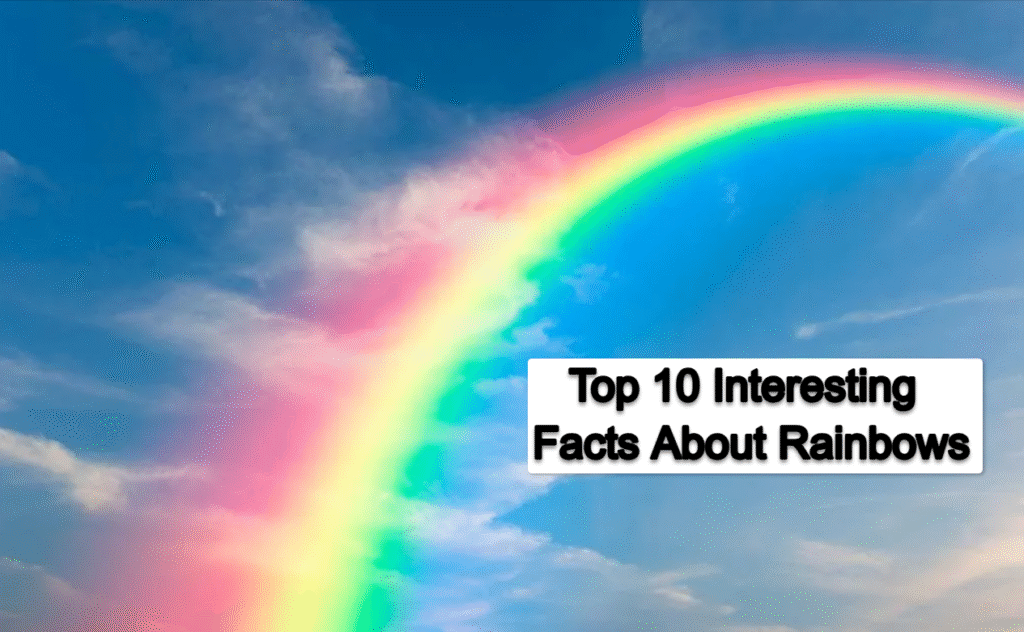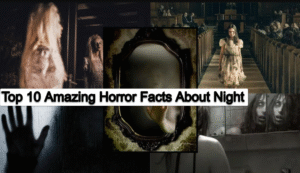Top 10 Interesting Facts About Rainbows

Top 10 Interesting Facts About Rainbows
Rainbows are among the most stunning natural wonders of the world. If the sky clears following rain and the sun shines, a rainbow is like magic! The bright arc of color in the sky is loved by all old and young. Have you ever thought about the process of making rainbows, or why they are numerous hues? Let’s look at some fun and Top 10 Interesting Facts About Rainbows that’ll help you love them more!
Interesting Facts About Rainbows
1. Rainbows Are Made by Sunlight and Rain
Rainbows are formed as sunlight passes through raindrops that fall from the sky. The light bends when it passes through the drop, it then reflects off the interior of the drop and then exits across a variety of shades. This is known as reflection, reflection, and dispersion. It results in a stunning rainbow visible on the sky.
2. A Rainbow Has Seven Colors
The rainbow comes in seven distinct colors. They include red, orange yellow, green blue, indigo, as well as violet. They occur in the same order in the same order, with red visible on the exterior and purple inside. The order is often remembered with the abbreviation “ROYGBIV.” The color of each is a part of the visible spectrum.
3. You Can Only See a Rainbow at a Certain Angle
To see a rainbow you’ll need sunlight behind your eyes, and mist or rain in front of you. What angle sunlight hits the raindrops vital. Rainbows are visible when the light strikes the raindrops with the angle 42°. This is the reason why rainbows typically occur in the evening or early morning hours when the sun is higher in the sky.
4. Rainbows Are Circles, Not Arcs
Although we often think of rainbows as arcs actually complete circles! The reason we don’t get the whole circle is because the ground blocks a portion of the. If you were on an airplane or on top of the mountain, you might be able to see a complete circle of rainbow. A few lucky individuals have witnessed full rainbows from high buildings or from the skies when flying!
5. Double Rainbows Are Real
Sometimes, you may observe not only two, but three rainbows over the sky! This is known as double rainbow. The second rainbow is typically less visible and is located above it. It is also known as a double rainbow. Double rainbows are when the color order of the second one reverses by having red inside and violet outside.
6. No Two People See the Same Rainbow
This might sound a bit odd however, there are no two people who see the identical rainbow. The formation of a rainbow is caused by the reflection of light off raindrops at a certain angle. Because each person is at an individual location, they can are able to see light reflections reflecting off various raindrops. Even though two people can look to the exact same sky, they’re seeing different reflections of light.
7. Moonbows: Rainbows at Night
Did you realize that rainbows can occur even at night? The rare and beautiful rainbows known as moonbows. They originate from the moon’s light rather than the sun. Moonbows appear less vivid than regular rainbows, due to the moon’s light source is not as intense as that of the sun’s. They usually appear pale or white due to the light source being dim.
8. Rainbows Don’t Appear Everywhere
Rainbows require certain conditions for them to grow, and they don’t occur everywhere around the globe. Rainbows are most common in areas that experience regular sunshine and rain in tropical areas, for instance. Certain locations, such as Hawaii are famous for the abundance of rainbows they see all through the all year. In areas with less rainfall, such as deserts the rainbows are less common.
9. Myths and Legends About Rainbows
Rainbows are a component of numerous legends and myths all over the globe. In certain societies there was a belief that rainbows were bridges between Earth and the sky. The ancient Greeks believed that rainbows were a path created by goddess Iris as she travelled through the sky to send messages. In Ireland there’s an old legend that states the leprechauns hid their gold pots at the at the end of a rainbow!
10. There’s No Actual “End” to a Rainbow
The most fascinating aspects of rainbows is the fact that there’s no real “end” to the rainbow. The rainbow is created by the reflection of light on raindrops Since light doesn’t cease, the rainbow will never stop either. What is the “end” of the rainbow is determined by where you stand. If you move the rainbow appears to move along with you, therefore you won’t get to the end!
Conclusion
Rainbows aren’t just beautiful but also filled with fascination and scientific knowledge. From their seven vivid hues to how they are formed within the skies, they continue to awe and delight everyone around the globe. Therefore when you spot a rainbow after a rainy day, be sure to take a moment to take in this beautiful nature-inspired gift!






